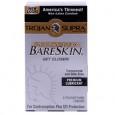Although rare, many people do suffer from an allergic reaction to latex condoms or spermicidal lubricants, which can result in mild to severe symptoms.
In rare cases, these allergies can result in death due to anaphylaxis. Condoms, however, protect both partners from unwanted pregnancy and the transmission of sexually transmitted diseases, such as HIV.
Condom manufacturers have developed numerous hypoallergenic condoms, which entail the same benefits as latex condoms but without the harsh side effects.
Disclaimer: condom-sizes.org is supported by its readers. When you buy through links on our site, we may earn an affiliate commission. Learn more.
How to know if you are allergic or not
You might be allergic if you experience frequent and unexplained itching after sex. This condition may also happen due to an extra ingredient, such as spermicide, which you or your partner used.
If you are allergic to condoms, latex is the most frequent offender. Many latex allergies grow gradually, happening after decades of repeated exposure.
Allergy to Spermicide
People with an allergy to spermicidal lubricants have the most options. Simply, they avoid condoms with spermicidal lubricants. Although these types of condoms do help prevent pregnancy at a higher rate by killing sperm that might escape the condom, they make up a minority sector of the market.
For the most part, the typical condom does not contain spermicide. People can still use lubricated condoms that do not contain the chemical nonoxynol-9. People with a latex allergy have fewer options.
HYPOALLERGENIC CONDOM OPTIONS
Despite a latex allergy, partners can benefit from the use of condoms by choosing non-latex options, which many companies design and construct from animal products, such as lambskin, or synthetic products, such as polyurethane and polyisoprene condoms.
Lambskin condoms, which condom companies have manufactured out of lamb intestines, do not completely protect either partner from the transmission of STIs. They also tend to slip and break more than latex condoms. However, people with an allergy to latex condoms do not have much choice, and the research indicates they have much better odds at preventing pregnancy and diseases when using these condoms than not using one at all.
Men should keep a variety of condoms with them. They might not have an allergy, but they might encounter a partner that does. All of the major condom manufacturers have hypoallergenic options, so it should not inconvenience anyone.
Trojan, for example, sells the Trojan Bareskin SUPRA, which they have developed out of polyurethane. They also have their Naturalamb condoms, which they have made from lamb skin. They recommend these products for monogamous couples because of the decreased protection they offer against sexually transmitted diseases.
Durex manufactures and sells the Avanti Bare RealFeel condoms made of polyisoprene, which they market as the first non-allergenic latex condom. With these condoms, couples can have the benefits of latex condoms but without the risks.
Lifestyles also offers a hypoallergenic condom option – Lifestyles SKYN condom made out of polyisoprene. It comes in two sizes – regular (53mm condom width) and large (56mm condom width).
All of the above mentioned options are regular male condoms, but did you know that a female condom FC2 is also a good choice for people with latex allergy? It is made out of synthetic nitrile so it’s 100% latex-free. What’s special about this condom is that it can be used by couples whatever the penis size. So no matter whether you usually use a small, regular or large male condom, you can practice safe sex with FC2 female condom without worrying if it will fit.
People with latex and nonoxynol-9 allergies have many options in the condom marketplace. Upon discovering the source of their allergic reaction, they can choose a condom that will work to enjoy safe and pleasure sexual experiences without ill effects.
Conclusion
Though latex condoms are most commonly available and can offer the best protection against most STDs when used properly and consistently, you will find many different reasons why couples choose non-latex options.
People allergic to latex have to use non-latex condoms so they could prevent unpleasant symptoms. Other couples favor the skin-like sensation of lambskin or polyisoprene condoms.
Polyurethane condoms are generally thinner (some of the thinnest condoms in the world are made out of polyurethane) and are better at transferring heat, which means more sensation and more pleasure.This will justify a bit higher cost for many customers.
References
-
1. Marfatia, Y. S., Pandya, I., & Mehta, K. (2015). Condoms: Past, present, and future. Indian journal of sexually transmitted diseases, 36(2), 133.
2. Wiederman, M. W. (2015). Sexual script theory: Past, present, and future. In Handbook of the sociology of sexualities (pp. 7-22). Springer, Cham.
3. Yah, C. S., Simate, G. S., Hlangothi, P., & Somai, B. M. (2018). Nanotechnology and the future of condoms in the prevention of sexually transmitted infections. Annals of African medicine, 17(2), 49.
4. Macaluso, M., Blackwell, R., Jamieson, D. J., Kulczycki, A., Chen, M. P., Akers, R., … & Duerr, A. (2007). Efficacy of the male latex condom and of the female polyurethane condom as barriers to semen during intercourse: a randomized clinical trial. American journal of epidemiology, 166(1), 88-96.
5. Colquitt, C. W., & Martin, T. S. (2017). Contraceptive methods: A review of nonbarrier and barrier products. Journal of pharmacy practice, 30(1), 130-135.
6. Walsh, T. L., Frezieres, R. G., Peacock, K., Nelson, A. L., Clark, V. A., & Bernstein, L. (2003). Evaluation of the efficacy of a nonlatex condom: results from a randomized, controlled clinical trial. Perspectives on Sexual and Reproductive Health, 35(2), 79-86.






 Peter started condom-sizes.org in 2011 after realizing what a difference using a proper condom size really makes! In 2012 he published an e-book called 'How to Find Your Perfect Condom' which is still available on
Peter started condom-sizes.org in 2011 after realizing what a difference using a proper condom size really makes! In 2012 he published an e-book called 'How to Find Your Perfect Condom' which is still available on